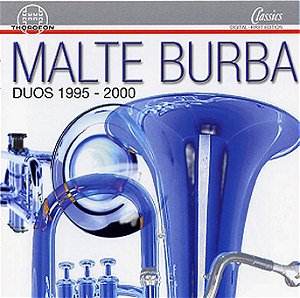A friend of mine boasts that he never reads a
CD booklet, he plays the disc, listens but wants no more. Well
I think that even he might look inside the pages of this CD even
if out of sheer curiosity and bemusement. Mind you if he did he
wouldn’t get very far because there is very little said and what
is said, is either uninformative or quaintly translated from the
German. It’s worth searching out the CD just for the quote "this
piece is scored for bras"!
This is the most bizarre CD I have ever encountered
and for almost the first time I am speechless. To describe music
in words anyway is a thankless task but this music is virtually
impossible. However I will attempt, as far as I can, to explain
to you what is going on. If you are interested in exploration,
eccentricity and ‘off the wall’ music then this is most definitely
for you.
Malte Burba is a composer, in case you wondered,
and a versatile, virtuoso brass player. The short CV tells us
that he ranks amongst the most interesting brass players of our
time. We are also told, intriguingly, that "he put together
an entire scientific puzzle of anatomy, physiology, pneumatics,
acoustics and neurology to develop his innovative training concept
which, when combined with sensitive artistic intuition, leads
to extraordinary musical experiences". So, now that’s clear.
The inspiration behind this disc is Frank Sinatra’s
first ‘Duets’ record in which the great man is joined by friends
with whom ... well ... he duets. Burba, who is pictured within,
thought that this idea should extend to new music as well. His
project took ten years to mature. Sadly the booklet tells us nothing
at all about the other composers and musicians involved and about
the inspiration behind each piece. Some last not much more than
two minutes and none more than five so is it entirely possible
that the listener will be totally bewildered by the plethora of
new and weird sounds which unaccountably passes by.
All fifteen of the works on this CD therefore,
were written for Malte Burba with one other player, or with sampled
electro-acoustic noises or for duetting with himself. In one,
by Hans Joachim Hespos he makes burps, raspberries, various other
mouth noises and possibly farts. I can’t, I’m pleased to say,
be sure. He mixes these noises with the odd similarly sounding
one which comes I believe from a trumpet.
It is almost as if the composers are trying to
outdo each other in trickery. It is presumably helpful that several
of the composers, for example, Harald "Sack" Ziegler,
act as his duet partner. Burba plays on four instruments including
apparently the Didgeridoo, which I simply cannot hear. This curiosity
makes a later appearance in Flueler’s ‘Dido Madgedgteril’ where
it can certainly be heard. More conventionally, Adriana Holszky
accompanies her piece on the concert grand. However this grand
has been so prepared that it manages to sound like an electronic
instrument. Erwin Stache is one of several composers who partner
Burba with sampled electronic sounds during the performance and
recording process. This gives the impression of creating composition
‘on the fly’. It is typical in that he takes one basic soundworld
lets it grow to a small climax and then phases out.
And then in the midst of these series of rather
similar sounding pieces consisting of blips and blops and burps
comes, quite out the blue, Caccini’s ‘Amarilli mia bella’ and
the ‘Air on a G string’ by Bach. These are in anonymous dis-arrangements:
the first for trumpet and organ; the second mostly reharmonized
for various brass instruments with sampled noises in the background.
Incidentally this last piece makes a strong contrast - following
without a break after Ziegler’s piece with its ostinato rock beat
and high repetitive trumpet glissandi.
Towards the end of the CD we are suddenly and
unexpectedly treated to a bit of what I believe is now termed
‘lounge jazz’ in Lari-Fari by Bronner. This offers an opportunity,
in its middle section, for Burba to produce some very authentic
jazz improvisation. The last work is scored for four trumpets
(Burba triple tracked) bird noises and siren. The latter ends
the piece and therefore the CD followed by the loud ‘clank’ of
I think a prison door shutting. A somewhat intimidating ending.
The disc is quite bewildering and absurd, witty,
ridiculous and pretentious; and a complete waste of time. You
can dine out on it for months, buy it.
Gary Higginson
Full Listing
Harald „Sack“ Ziegler (*1961): Maltematik
für Trompete, Euphonium, Alphorn, Didgeridoo
Partner: Harald „Sack“ Ziegler
Johann Sebastian Bach (1685-1750): Air
für Trompete & gesampelte sounds von Trompete, Euphonium,
Alphorn
Partner: Chris Walden (*1966)
Nikolaus Heyduck (*1957): Duo
für Alphorn und Klavier, Partner: Nikolaus Heyduck
Claus Kühnl (*1957): Morceau 1995
für Trompete & Konzertflügel, Partner: Claus Kühnl
Felix Hochuli (*19544): Alp-Pong
für 2 Alphörner, Partner: Lutz Mandler (*1967)
Giulio Caccini (1545-1618): Amarilli mia bella
für Trompete & Orgel, Partner: Otto-Jürgen Burba
(1929)
Heiner Goebbels (*1952): Nachtstück II
für Trompete & gesampelte sounds von Trompete, Alphorn,
Euphonium
Partner: Heiner Goebbels
Hans Joachim Hespos (*1938): splisse
Duett für Trompete Solo
Erwin Stache (*1960): atme
für Euphonium & gesampelten Atem, Partner: Erwin Stache
Malte Burba (*1957): AxAl
für Trompete & Percussion
Partner: Axel Dörner (*1964) & Albrecht Riermeier (*1951)
Adriana Hölszky (*1953): Duo
für Trompete & Konzertflügel, Partnerin: Adriana
Hölszky
Helmut W. Erdmann (*1947): SOUNDING PICTURE
für Alphorn & Flöten & Live-Elektronik, Partner:
Helmut W. Erdmann
Till Brönner (*1971): Lari-Fari
für 2 Trompeten & Combo, Partner: Till Brönner
Christhop Flueler (*1967): DidoMadgedgteril
für Didgeridoo & digitale Elektronik, Partner: Christoph
Flueler
Rudolf Linder (*1952): Iso-Starr
für 4 Trompete (gleichzeitig), Partner: Rudol Linder
